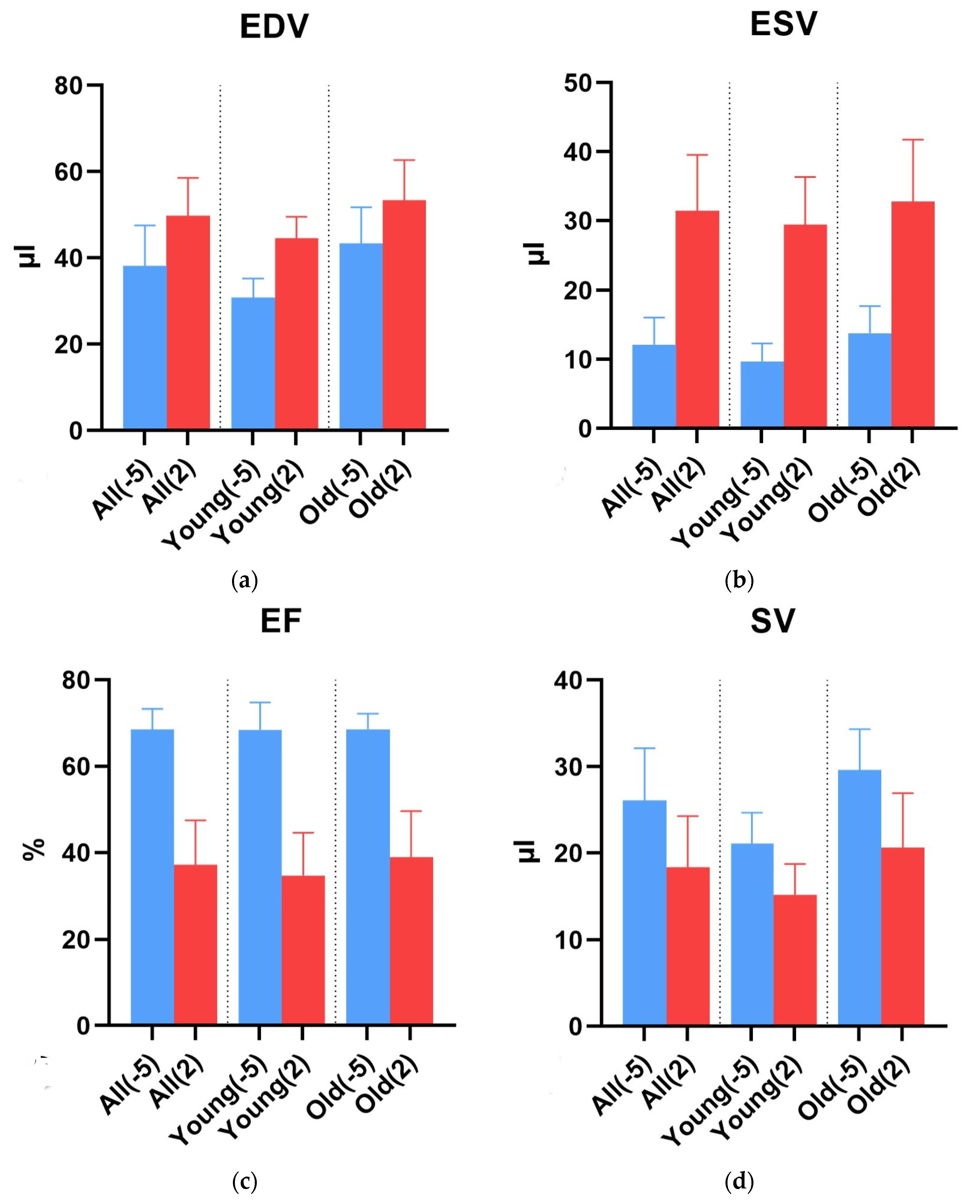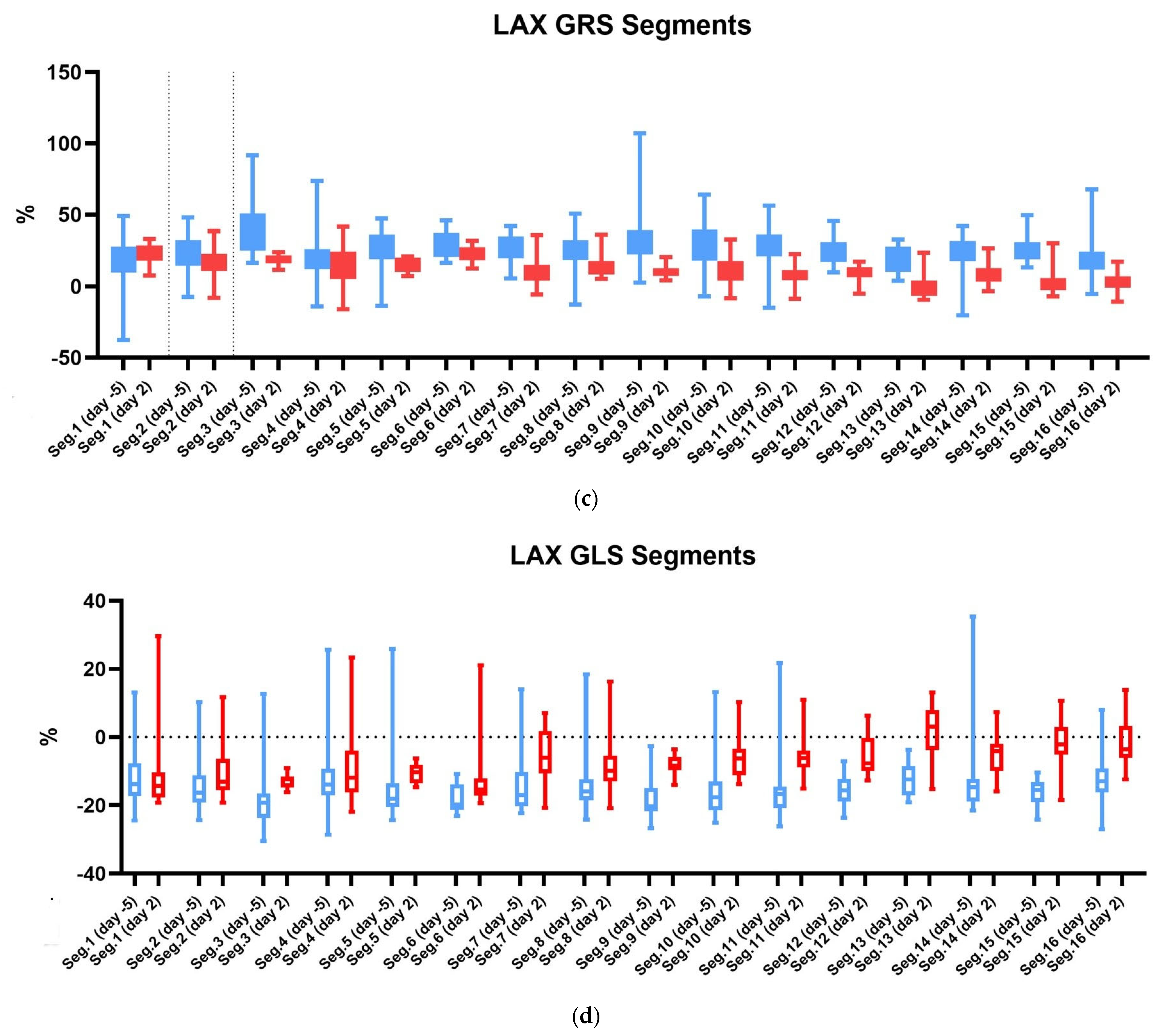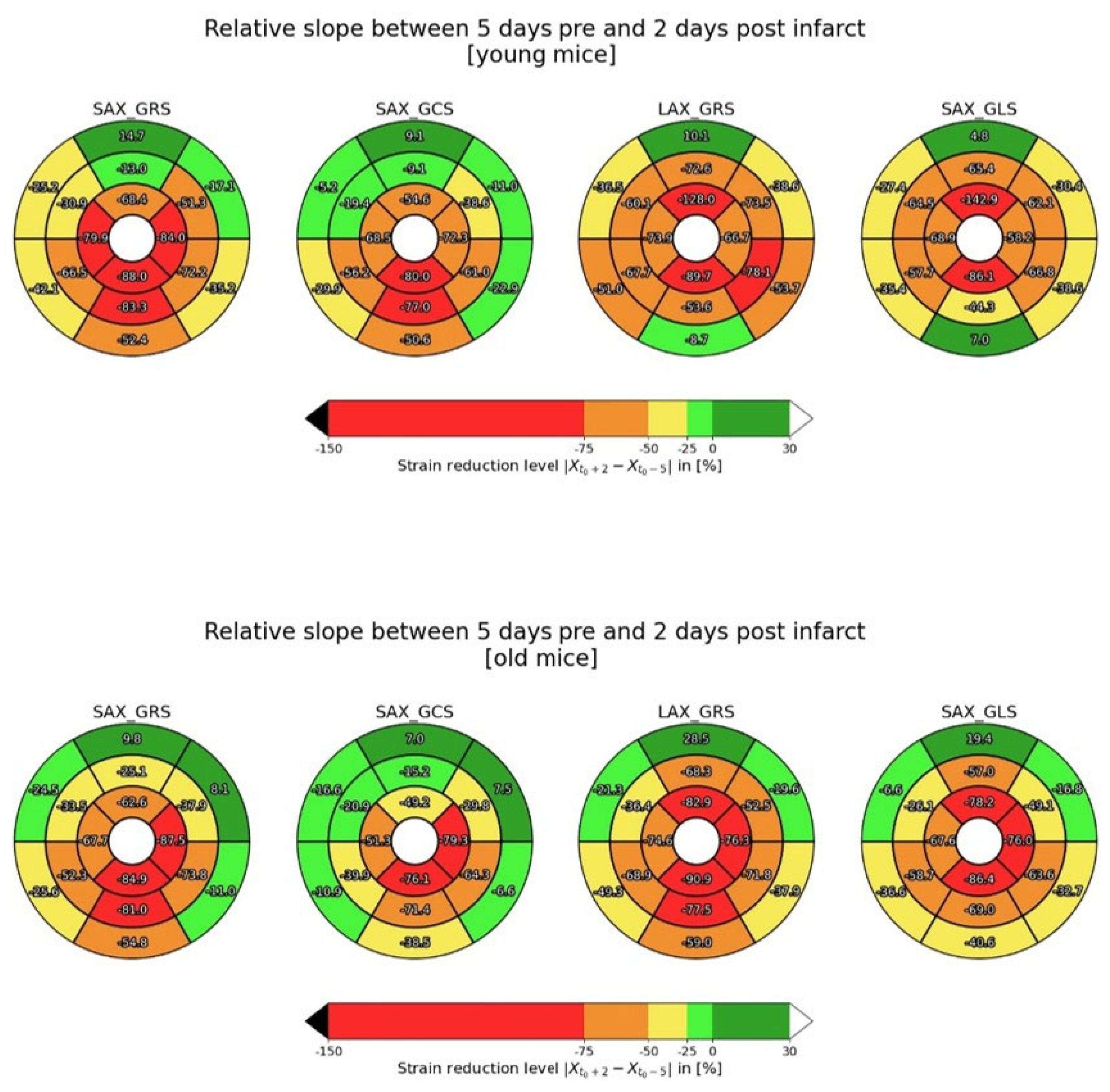Comparison of Myocardial Function in Young and Old Mice During Acute Myocardial Infarction: A Cardiac Magnetic Resonance Study
Abstract
1. Introduction
2. Materials and Methods
2.1. Study Design and Animal Model
2.2. Left Anterior Descending Artery (LAD) Ligation
2.3. Cardiac Magnetic Resonance (CMR) Imaging
- Planning scans;
- 1 short-axis stack, comprising 7 independent slices from the heart basis to the apex; integrated Cine-FLASH sequence with navigator echo (Bruker); TE/TR, 2.2/8.6 ms; FA, 15°; FoV, 29.5 × 25.1 mm; matrix, 210 × 180; resolution, 140 × 140 µm; slice thickness, 1 mm; oversampling, 140; 14 movie frames; navigator parallel to slice; TA per slice, 2:46 min:s;
- 3 long-axis cine scans: 1-, 2-, and 3-camber view (same scan parameters as short-axis stacks).
2.4. Statistical Analysis
3. Results
3.1. Functional Parameters
3.2. Global Strain
3.3. Segmental Strain
4. Discussion
Limitations
5. Conclusions
Author Contributions
Funding
Institutional Review Board Statement
Informed Consent Statement
Data Availability Statement
Conflicts of Interest
References
- Scharlach, D.; Schmitz, T.; Raake, P.; Linseisen, J.; Meisinger, C. Causes of death and trends in mortality from the year 2000 to 2017 in patients with acute myocardial infarction. Ann. Med. 2024, 56, 2424449. [Google Scholar] [CrossRef]
- World Health Organization. The Top 10 Causes of Death; World Health Organization: Geneva, Switzerland, 2020. [Google Scholar]
- Sood, A.; Singh, A.; Gadkari, C. Myocardial Infarction in Young Individuals: A Review Article. Cureus 2023, 15, e37102. [Google Scholar] [CrossRef]
- Wereski, R.; Kimenai, D.M.; Bularga, A.; Taggart, C.; Lowe, D.J.; Mills, N.L.; Chapman, A.R. Risk factors for type 1 and type 2 myocardial infarction. Eur. Heart J. 2022, 43, 127–135. [Google Scholar] [CrossRef]
- Yang, J.; Biery, D.W.; Singh, A.; Divakaran, S.; DeFilippis, E.M.; Wu, W.Y.; Klein, J.; Hainer, J.; Ramsis, M.; Natarajan, P.; et al. Risk Factors and Outcomes of Very Young Adults Who Experience Myocardial Infarction: The Partners YOUNG-MI Registry. Am. J. Med. 2019, 133, 605–612.e1. [Google Scholar] [CrossRef]
- Strait, J.B.; Lakatta, E.G. Aging-associated cardiovascular changes and their relationship to heart failure. Heart Fail. Clin. 2012, 8, 143–164. [Google Scholar] [CrossRef]
- Ibanez, B.; James, S.; Agewall, S.; Antunes, M.J.; Bucciarelli-Ducci, C.; Bueno, H.; Caforio, A.L.; Crea, F.; Goudevenos, J.A.; Halvorsen, S.; et al. 2017 ESC Guidelines for the management of acute myocardial infarction in patients presenting with ST-segment elevation: The Task Force for the management of acute myocardial infarction in patients presenting with ST-segment elevation of the European Society of Cardiology (ESC). Eur. Heart J. 2018, 39, 119–177. [Google Scholar]
- Phoon, C.K.L.; Turnbull, D.H. Cardiovascular Imaging in Mice. Curr. Protoc. Mouse Biol. 2016, 6, 15–38. [Google Scholar] [CrossRef]
- Gilson, W.D.; Kraitchman, D.L. Cardiac magnetic resonance imaging in small rodents using clinical 1.5 T and 3.0 T scanners. Methods 2007, 43, 35–45. [Google Scholar] [CrossRef]
- Janssen, P.M.L.; Biesiadecki, B.J.; Ziolo, M.T.; Davis, J.P. The Need for Speed: Mice, Men, and Myocardial Kinetic Reserve. Circ. Res. 2016, 119, 418–421. [Google Scholar] [CrossRef]
- Ichikawa, Y.; Sakuma, H.; Kitagawa, K.; Ishida, N.; Takeda, K.; Uemura, S.; Motoyasu, M.; Nakano, T.; Nozaki, A. Evaluation of left ventricular volumes and ejection fraction using fast steady-state cine MR imaging: Comparison with left ventricular angiography. J. Cardiovasc. Magn. Reson. 2003, 5, 333–342. [Google Scholar] [CrossRef]
- Götte, M.J.; van Rossum, A.C.; Twisk, J.W.; Kuijer, J.P.; Marcus, J.T.; Visser, C.A. Quantification of regional contractile function after infarction: Strain analysis superior to wall thickening analysis in discriminating infarct from remote myocardium. J. Am. Coll. Cardiol. 2001, 37, 808–817. [Google Scholar] [CrossRef] [PubMed]
- West, A.M.; Kramer, C.M. Cardiovascular magnetic resonance imaging of myocardial infarction, viability, and cardiomyopathies. Curr. Probl. Cardiol. 2010, 35, 176–220. [Google Scholar] [CrossRef]
- Bottini, P.B.; Carr, A.A.; Prisant, L.M.; Flickinger, F.W.; Allison, J.D.; Gottdiener, J.S. Magnetic resonance imaging compared to echocardiography to assess left ventricular mass in the hypertensive patient. Am. J. Hypertens. 1995, 8, 221–228. [Google Scholar] [CrossRef] [PubMed]
- Ilyas, I.; Little, P.J.; Liu, Z.; Xu, Y.; Kamato, D.; Berk, B.C.; Weng, J.; Xu, S. Mouse models of atherosclerosis in translational research. Trends Pharmacol. Sci. 2022, 43, 920–939. [Google Scholar] [CrossRef] [PubMed]
- Bujak, M.; Kweon, H.J.; Chatila, K.; Li, N.; Taffet, G.; Frangogiannis, N.G. Aging-related defects are associated with adverse cardiac remodeling in a mouse model of reperfused myocardial infarction. J. Am. Coll. Cardiol. 2008, 51, 1384–1392. [Google Scholar] [CrossRef]
- Jugdutt, B.I.; Jelani, A. Aging and defective healing, adverse remodeling, and blunted post-conditioning in the reperfused wounded heart. J. Am. Coll. Cardiol. 2008, 51, 1399–1403. [Google Scholar] [CrossRef]
- Andre, F.; Steen, H.; Matheis, P.; Westkott, M.; Breuninger, K.; Sander, Y.; Kammerer, R.; Galuschky, C.; Giannitsis, E.; Korosoglou, G.; et al. Age- and gender-related normal left ventricular deformation assessed by cardiovascular magnetic resonance feature tracking. J. Cardiovasc. Magn. Reson. 2015, 17, 25. [Google Scholar] [CrossRef]
- Anzai, T.; Yamagata, T.; Uosaki, H. Comparative Transcriptome Landscape of Mouse and Human Hearts. Front Cell. Dev. Biol. 2020, 8, 268. [Google Scholar] [CrossRef]
- Hammouda, K.; Khalifa, F.; Abdeltawab, H.; Elnakib, A.; Giridharan, G.A.; Zhu, M.; Ng, C.K.; Dassanayaka, S.; Kong, M.; Darwish, H.E.; et al. A New Framework for Performing Cardiac Strain Analysis from Cine MRI Imaging in Mice. Sci. Rep. 2020, 10, 7725. [Google Scholar] [CrossRef]
- Daal, M.R.R.; Strijkers, G.J.; Calcagno, C.; Garipov, R.R.; Wüst, R.C.I.; Hautemann, D.; Coolen, B.F. Quantification of Mouse Heart Left Ventricular Function, Myocardial Strain, and Hemodynamic Forces by Cardiovascular Magnetic Resonance Imaging. J. Vis. Exp. 2021, 2021, e62595. [Google Scholar] [CrossRef]
- Onishi, R.; Ueda, J.; Ide, S.; Koseki, M.; Sakata, Y.; Saito, S. Application of Magnetic Resonance Strain Analysis Using Feature Tracking in a Myocardial Infarction Model. Tomography 2023, 9, 871–882. [Google Scholar] [CrossRef] [PubMed]
- Liu, P.; Xu, B.; Cavalieri, T.A.; Hock, C.E. Age-related difference in myocardial function and inflammation in a rat model of myocardial ischemia-reperfusion. Cardiovasc. Res. 2002, 56, 443–453. [Google Scholar] [CrossRef] [PubMed]






| Young | Old | All | ||||
|---|---|---|---|---|---|---|
| MV ± SD | Delta (MV ± SD) | MV ± SD | Delta (MV ± SD) | MV ± SD | Delta (MV ± SD) | |
| Age [days] | 83.3 ± 2.9 | 634.8 ± 49.0 | 407.7 ± 282.2 | |||
| EDV day -5 [µL] | 30.8 ± 4.4 | 13.8 ± 8.4 | 43.5 ± 8.3 | 10.0 ± 10.5 | 38.3 ± 9.3 | 11.6 ± 9.6 |
| EDV day 2 [µL] | 44.6 ± 4.9 | 53.4 ± 9.3 | 49.8 ± 8.8 | |||
| ESV day -5 [µL] | 9.7 ± 2.6 | 19.7 ± 9.1 | 13.8 ± 3.9 | 19.0 ± 10.3 | 12.1 ± 3.9 | 19.3 ± 9.5 |
| ESV day 2 [µL] | 29.4 ± 6.9 | 32.8 ± 9.0 | 31.4 ± 8.1 | |||
| SV day -5 [µL] | 21.1 ± 3.6 | −5.9 ± 5.5 | 29.7 ± 4.7 | −9.0 ± 5.4 | 26.1 ± 6.0 | −7.7 ± 5.5 |
| SV day 2 [µL] | 15.2 ± 3.6 | 20.6 ± 6.3 | 18.4 ± 5.9 | |||
| EF day -5 [%] | 68.5 ± 6.3 | −33.8 ± 14.8 | 68.7 ± 3.6 | −29.8 ± 12.4 | 68.6 ± 4.7 | −31.4 ± 13.1 |
| EF day 2 [%] | 34.7 ± 10.0 | 38.9 ± 10.8 | 37.1 ± 10.3 | |||
| SAX GRS day -5 [%] | 32.4 ± 6.3 | −18.9 ± 9.7 | 31.2 ± 5.1 | −16.6 ± 4.1 | 31.7 ± 5.5 | −17.6 ± 6.8 |
| SAX GRS day 2 [%] | 13.5 ± 3.7 | 14.6 ± 3.8 | 14.1 ± 3.7 | |||
| SAX GCS day -5 [%] | −18.7 ± 2.2 | 8.9 ± 4.3 | −18.0 ± 2.1 | 7.6 ± 1.9 | −18.3 ± 2.1 | 8.1 ± 3.1 |
| SAX GCS day 2 [%] | −9.8 ± 2.3 | −10.4 ± 2.2 | −10.2 ± 2.2 | |||
| LAX GRS day -5 [%] | 26.3 ± 7.5 | −17.1 ± 6.8 | 22.9 ± 5.6 | −13.6 ± 5.7 | 24.3 ± 6.5 | −15.0 ± 6.2 |
| LAX GRS day 2 [%] | 9.2 ± 2.2 | 9.4 ± 3.4 | 9.3 ± 2.9 | |||
| LAX GLS day -5 [%] | −16.2 ± 3.2 | 9.4 ± 3.0 | −14.5 ± 3.6 | 7.4 ± 3.6 | −15.2 ± 3.4 | 8.2 ± 3.5 |
| LAX GRS day 2 [%] | −6.9 ± 1.3 | −7.0 ± 2.2 | −7.0 ± 1.9 | |||
| p-Values | Young/Old Day -5 | Young/Old Day 2 | Young Day -5/Day 2 | Old Day -5/Day 2 |
|---|---|---|---|---|
| EDV | 0.002 | 0.038 | 0.005 | 0.015 |
| ESV | 0.029 | 0.418 | 0.0012 | 0.0002 |
| SV | 0.001 | 0.06 | 0.031 | 0.0005 |
| EF | 0.951 | 0.475 | 0.0009 | <0.0001 |
| SAX GRS | 0.675 | 0.568 | 0.0021 | <0.0001 |
| SAX GCS | 0.508 | 0.595 | 0.0016 | <0.0001 |
| LAX GRS | 0.302 | 0.895 | 0.0005 | <0.0001 |
| LAX GLS | 0.308 | 0.873 | 0.0002 | 0.0001 |
Disclaimer/Publisher’s Note: The statements, opinions and data contained in all publications are solely those of the individual author(s) and contributor(s) and not of MDPI and/or the editor(s). MDPI and/or the editor(s) disclaim responsibility for any injury to people or property resulting from any ideas, methods, instructions or products referred to in the content. |
© 2025 by the authors. Licensee MDPI, Basel, Switzerland. This article is an open access article distributed under the terms and conditions of the Creative Commons Attribution (CC BY) license (https://creativecommons.org/licenses/by/4.0/).
Share and Cite
Dalmer, A.; Wörner, P.; Manzke, M.; Gäbel, R.; Lindner, T.; Meinel, F.G.; Weber, M.-A.; David, R.; Lang, C.I. Comparison of Myocardial Function in Young and Old Mice During Acute Myocardial Infarction: A Cardiac Magnetic Resonance Study. Diagnostics 2025, 15, 1447. https://doi.org/10.3390/diagnostics15121447
Dalmer A, Wörner P, Manzke M, Gäbel R, Lindner T, Meinel FG, Weber M-A, David R, Lang CI. Comparison of Myocardial Function in Young and Old Mice During Acute Myocardial Infarction: A Cardiac Magnetic Resonance Study. Diagnostics. 2025; 15(12):1447. https://doi.org/10.3390/diagnostics15121447
Chicago/Turabian StyleDalmer, Antonia, Paul Wörner, Mathias Manzke, Ralf Gäbel, Tobias Lindner, Felix G. Meinel, Marc-André Weber, Robert David, and Cajetan I. Lang. 2025. "Comparison of Myocardial Function in Young and Old Mice During Acute Myocardial Infarction: A Cardiac Magnetic Resonance Study" Diagnostics 15, no. 12: 1447. https://doi.org/10.3390/diagnostics15121447
APA StyleDalmer, A., Wörner, P., Manzke, M., Gäbel, R., Lindner, T., Meinel, F. G., Weber, M.-A., David, R., & Lang, C. I. (2025). Comparison of Myocardial Function in Young and Old Mice During Acute Myocardial Infarction: A Cardiac Magnetic Resonance Study. Diagnostics, 15(12), 1447. https://doi.org/10.3390/diagnostics15121447






